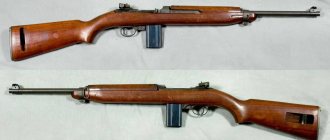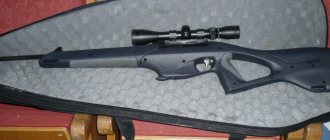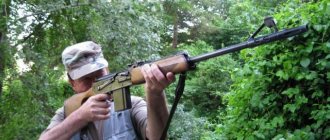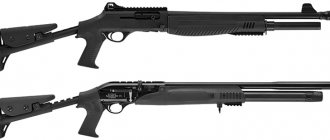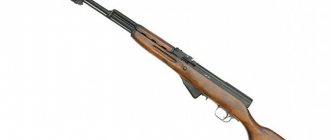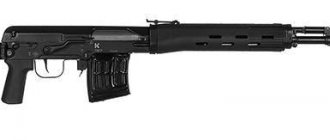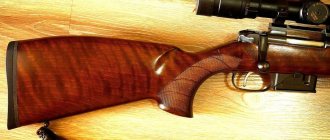M1 Carbine (USA)
M1 carbine, left view.
The same carbine, view from the right.
The M1A1 carbine is an airborne version with a folding stock.
M2 carbine, with a 30-round magazine and automatic fire capability.
The .30 M1 carbine cartridge (7.62x33mm, left) compared with the Russian 7.62x39mm cartridge (center) and 5.56x45mm NATO (.223 Rem, right).
Caliber
: .30 US Carbine (7.62×33 mm)
Automatic type
: gas operated, locking by turning the bolt
Length
: 904 mm
Barrel length
: 458 mm
Weight
: 2.36 kg without cartridges
Magazine
: 15 or 30 cartridges, box-shaped, detachable
The American M1 carbine, which became one of the most popular small arms of the Second World War (its production exceeded 6 million copies), is a very interesting and in some sense a unique example of small arms. For the first time, talk about creating a lightweight self-loading carbine designed to replace standard self-loading pistols for second-line military personnel in the US Army began in earnest in 1938. It is known that teaching a person to shoot more or less accurately from a carbine is much easier than from a pistol, and therefore cheaper. In addition, the carbine has a noticeably greater aiming and effective firing range, and at the same time can be relatively light and compact. Thus, in 1938, the concept of PDW - Personal Defense Weapon, that is, an individual self-defense weapon for military personnel who are not entitled to a full-fledged rifle according to the state (clerks, car drivers, gun crews, etc.) was first voiced, although not in a completely modern form. P.). For 2 years, practically no work was carried out on this topic, and only in 1940 did the US Army seriously take up the new model. For this purpose, the well-known company Winchester was given the task of creating a new cartridge for a carbine, intermediate in power between a pistol and a rifle. Such a cartridge was soon developed - it had a cylindrical sleeve 33 millimeters long without a protruding rim and a pistol-type jacketed bullet with an ogive head. Bullet weight is 7.1 grams, initial speed is about 600 m/s, muzzle energy is about 1300 Joules. In terms of muzzle energy, the new cartridge, which received the official designation “cartridge, ball, .30 caliber, M1,” was two to more than two times superior to most standard pistol cartridges of that time, at the same time it was almost 3 times weaker in terms of muzzle energy standard rifle cartridge of the US Army .30-06 M2. It was the latter fact (together with the Americans’ passion for long-range shooting, which in general turned out to be not very popular or useful in a mass war) that explained the rather widespread (for Americans) prejudice about the “weakness” of the carbine. At the same time, at firing ranges from 0 to 500 meters (further shooting from a carbine was unrealistic and completely ineffective), the energy of its bullet was approximately 2 times higher than the energy of a 7.62mm bullet fired from the Soviet PPSh-41 submachine gun - and due to the lack of power of the PPSh , as a rule, neither those who used it nor those against whom it was used could complain.
After the development of the new cartridge was completed, its specifications, together with the technical specifications for the new carbine (according to the original conditions, the carbine was supposed to be able to fire automatically, but during testing it was decided to abandon this possibility) were distributed to many companies, but as a result, the winner was the design of all the same company Winchester. The Winchester carbine also has an interesting history. Initially, its prototype was created by several engineers of the company in their free time as a light hunting weapon. At the same time, the carbine was based on a gas-operated automatic circuit developed by designer David Williams, who at that time... was in prison for murder. When the company received the Army's requirements for a new lightweight carbine, a fully functional prototype was created on the basis of an existing design in just over a month. After the adoption of a new carbine under the original name “US M1 carbine” in 1941, orders for its production were placed with a number of companies: Winchester Firearms Co., Inland Manufacturing Division of the General Motors Corp., Underwood-Elliot-Fisher Co., Saginaw Steering Gear Division of the General Motors Corp., National Postal Meter Co., Quality Hardware & Machine Co., International Business Machines Corp (IBM), Standard Products Co. and Rock-Ola Co. The release of the new carbine was so successful that in 1944 contracts with all companies except Winchester and Inland were closed. During the period from July 1942 (the first deliveries) to September 1945 (the end of the Second World War), more than 6 million M1 carbines and its modifications were produced (including the version for the airborne troops with a folding stock M1A1 and the automatic version M2, which was a de- actually a full-fledged machine gun and produced in several hundred thousand copies in 1944-45). The M1 carbine and its modifications were widely used during World War II, especially in the Pacific theater of operations, where the carbine's compactness, combined with the light weight of the weapon and cartridge (i.e., a large portable ammunition load), made it an excellent tool for jungle warfare. However, in the small towns of old Europe, from which the Americans had to knock out the Germans house by house and street by street, the M1 carbines also performed quite well. These same carbines were also supplied to anti-Hitler resistance fighters, including being dropped into occupied France.
It should be noted that in Russian literature the M1 carbine is sometimes called the “Garand carbine” or “baby Garand”. Both of these names are of purely domestic origin, since no such names are found in any American source (monographs on the history of the Winchester company, on the history of the M1 carbine, other serious publications on US small arms). Of course, in the design of the M1 carbine there is a clear influence of the Garand rifle, but Garand himself had nothing to do with this carbine. Moreover, for the competition to select a carbine, John Garand presented his own model of a weapon, which was distinguished by a top-mounted (similar to a Bren machine gun) detachable box magazine, gas-operated automatics and a rotating bolt with five radial lugs.
Technically speaking, the M1 Carbine is a compact self-loading rifle fed from detachable 15-round box magazines. The automation is built on the basis of a gas engine with a short (about 8 mm) stroke of the gas piston. The gas chamber is located under the barrel, in its middle part. When fired, the piston with a short energetic push transfers energy to the bolt frame located inside the forend, under the barrel, and further operation of the automation occurs due to the inertia of the moving parts of the automation. The return spring is located in the forend, between the receiver and the front part of the bolt frame, which interacts with the gas piston. The gas piston does not have its own spring. The locking unit is similar to a similar unit of the M1 Garand rifle - the bolt of a similar design with two lugs in the front part is locked by turning to the right behind the cutouts in the receiver, the bolt frame is connected to the bolt by a lever on the right side of the receiver. The shutter cocking handle is located on this lever. The trigger trigger is also similar to the Garand design; the safety is located in the front of the trigger guard. In early samples, the safety was in the form of a button; on later samples, it took the form of a rotary lever, since in the heat of battle, soldiers often confused the safety with the magazine release button located nearby. The stock is wooden, with a semi-pistol grip. Sights - a front sight with side protective “wings” on the barrel and a diopter rear sight in the rear part of the receiver - on early models, reversible (at 2 ranges, 150 and 300 yards - 136 and 273 meters), on later models, smoothly adjustable. Late modifications of carbines have a lug under the barrel for mounting a bayonet; early M1 carbines were not equipped with a bayonet. Sometimes carbines were equipped with a special canvas pouch for 2 spare magazines, put on the butt to carry part of the ammunition directly on the weapon. Additionally, for the M1 carbines, the M8 muzzle grenade launcher was developed to launch rifle grenades using blank cartridges, as well as a removable flame arrester, useful when fighting at dusk or at night.
Modifications
:
M1A1
- an option for paratroopers, distinguished by a pistol grip and a side-folding metal butt. Produced in limited quantities (total production of about 150 - 200 thousand pieces).
M2
- option with the ability to conduct automatic fire at a rate of 750 rounds per minute. Along with the M2 carbine, a new 30-round horn magazine was also adopted, which is completely interchangeable with earlier 15-round magazines. The fire selector is on the left side of the receiver. The total production of M2 automatic carbines amounted to no more than 300 thousand units.
M3
- “sniper carbine”, a modification of the M2 automatic carbine, which consisted of installing special mounts for infrared night sights, as well as a removable flash suppressor. The M3 carbine was used in night combat operations during the wars in Korea and Vietnam.
Description of the M1 Garand rifle
The M1 Garand is a self-loading rifle, the automation of which is powered by the energy of powder gases removed from the barrel. It is locked by turning the bolt.
The gas piston and bolt carrier are a single unit; when turned, the bolt rests against two protrusions in the grooves of the receiver.
The trigger mechanism (trigger mechanism) is of a hammer type; it is made in the form of a separate module; when disassembling the weapon, it is completely removed and has a very simple and reliable design. It was so successful that subsequently the design of the M1 Garand rifle trigger was repeatedly copied when creating other types of weapons.
The rifle also had a very convenient safety lever in the form of a flag-lever, which was placed inside the trigger guard. A fighter could always determine by touch whether his rifle was on safety or not.
The rifle was fed using a pack that held eight rounds. It was inserted into the magazine through an open bolt and ejected through it after the ammunition was completely used up.
Thanks to the bolt delay, the frame remained in the rear position after the last ammunition was used, which significantly speeded up and facilitated the process of reloading the weapon. The fighter simply had to take out and insert the next pack of cartridges into the magazine.
This method of loading a rifle significantly increased its practical rate of fire, but also had some disadvantages. The ejection of an empty pack was accompanied by a characteristic sound, which could tell the enemy that the soldier had run out of ammunition. Often the Japanese took advantage of this and managed to run up and destroy the fighter.
However, experienced fighters learned to use even this disadvantage: they imitated the sound of an empty pack being thrown out of a magazine and calmly dealt with the enemy.
Loading a rifle using a pack also had one more weak point: the weapon could not be recharged. In addition, the requirements for the manufacturing quality of the pack itself were quite high.
Whether the clinking sound of an ejected pack was a serious drawback of the M1 Garand is still a matter of debate. This topic was once discussed at a meeting of American and German veterans, the latter called this shortcoming ridiculous, saying that it was simply impossible to hear such noise during a battle.
Sights consisted of a front sight, closed on both sides, and a diopter rear sight.
On sniper modifications, a mount for an optical sight was installed, which was shifted away from the axis of the weapon so as not to interfere with the extraction of cartridges and empty packs.
The stock of the M1 Garand rifle was made of wood, the fore-end and the upper pad came separately.
The M1 was equipped with a bayonet and a muzzle, which was used to shoot rifle grenades.
Pros and cons of the M1 Garand
The M1 Garand self-loading rifle is an excellent example of small arms, the main advantages of which were simplicity, reliability, excellent rate of fire and good accuracy of fire. Considering the fact that the M1 Garand was one of the first self-loading rifles, it can be considered an outstanding example of small arms, and its creator a talented weapons designer.
The advantages of the M1 over a conventional rifle were obvious. In one minute, the average shooter could fire almost twice as many shots as with a conventional repeating rifle.
The M1 also had disadvantages, almost all of them related to the ammunition that this rifle used. The cartridge had excessive power, which significantly heavier the design, making it unnecessarily complex and expensive.
All these problems were solved only after the advent of automatic weapons created for intermediate ammunition. But that's a completely different story.
Characteristics of the air rifle Ataman M2R Type 1 Tactic Carbine 215/RB (5.5 mm PCP)
| Brand | Ataman (LLC Demyan) |
| Manufacturer country | Russia |
| Type | PCP air rifle |
| Combat analogue | No |
| Initial bullet speed | 300 m/s (up to gain 140) |
| Dimensions (Length) | 1100 mm |
| Caliber | 5.5 mm |
| Muzzle energy | up to 3.0 J |
| Receiver volume | 250 cc cm |
| Shooting mode | single |
| Recharge type | bolt platoon |
| Ammunition | lead bullet |
| Barrel type | threaded |
| Charge | 10 bullets |
| Energy source | high pressure receiver |
| Stock material | Tree |
| Mechanism material | Metal |
| Certificate | |
| Instructions | Instructions (passport) for the air rifle Ataman M2R Type 1 Tactic Carbine 215/RB (5.5 mm PCP) |
| Assembly diagram (Explosion diagram) | |
| Contents of delivery | Rifle, documentation, packaging, 1 magazine (drum), filling nipple |
Air rifle Ataman M2R Type 1 Tactical Carbine (215/RB 5.5 mm, magazine included) buy in the online store cccp-gun.ru at the best price on the Internet. The price for the Ataman M2R Type 1 Tactical Carbine Air Rifle (215/RB 5.5 mm, magazine included) is low, only 93,518 rubles. Delivery throughout Russia with payment upon receipt (cash on delivery).
PCP air rifle Ataman M2R Type 1 Tactical Carbine for hunting
- It is suitable for hunting small game or birds
- Shoots extremely quietly and accurately (at a distance of 20-25 meters, ducks do not hear the firing of shots and one magazine can hold almost the entire school of birds)
A rifle is also purchased for precision target shooting or recreational shooting.
To reduce the power of this model, a plug with a small through hole of 0.5 mm diameter is used; after dismantling the plug using a 6-sided wrench, the diameter of the through section increases to approximately 5-6 mm.
Like most Atman M2R Type 1 models, it is equipped with a fuse; the fuse moves in a plane perpendicular to the direction of movement of the bullet. The safety is located on the stock, between the sighting bar and the trigger guard above the trigger.
The source of energy in the PSP rifle is a high-pressure receiver, depending on the volume and settings in the 215 model; it is enough for 25 - 80 shots. The receiver volume is 250 cm3. There are several ways to refill a high-pressure receiver, namely:
1. Using a high pressure pump such as the Hatsan PCP Pump or the Hill 4 PCP Pump, both of these models are equipped with dryers to keep the rifle in working condition for a long period of use.
2. Using a filling station and a large volume cylinder, for example Armotech 6.8 l.
3. You can also fill the rifle with an electric high-pressure compressor, but at the moment all models of compressors of this type are still quite crude in terms of design and require serious modifications on the part of the owner.
